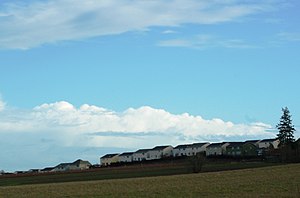| English: The urban growth boundary edge at Bull Mountain in the Portland metropolitan area. Farmland in foreground, urban development in background. From Roy Rogers Road near Bull Mountain Road. (Photo credit: Wikipedia) |
Sometimes it is just too easy to tune out NIMBY's as people who are too caught up in their own little world who have bought a house and expect nothing to change, and that anything they don't approve of should not be allowed anywhere near their little piece of paradise.
However, there is times that NIMBY's have a good point and one of those times is concerning higher density development. Now I am not talking about density done right, I am talking about density done wrong. A couple of years ago I mentioned a development near where I lived. It was a complex of condominiums that offered poor transit access and were designed that it was not easily accessed by pedestrians coming off the bus. Finally, it was not located near any retail stores so even for basics you have to get behind the wheel of a car to get.
Here is another example, recently in the comments on the Portland Transport blog that developers can get density incentives even if the project does not have easy transit access which is led to high density developments in areas with no or hard transit access. What is the purpose of having higher density if it will not have the benefit of transit access?
One solution to this would be modify the program so that it is a tiered system for incentives so that if locate on a high capacity transit line you get the highest incentives, basic transit service another level and the lowest to those farthest from transit access. In a perfect world you would not have any incentives for density outside transit corridors but you also have to face the political reality that you need to have the cooperation of all parties to get things done and the developers and other political elements would probably bulk a more restrict policy.
Another example of bad development is part of the problem above and that is high density developments in areas that should not have them. An example of this is here in Portland were several high density developments have been built in areas that are not designed for them such as out at the far end of the Urban Growth Boundary.
Spokane County is another example of areas that have allowed these kinds of developments. There has been several apartment complexes built in what is essentially rural areas that are on two lane roads with no access to services. Not only does this create traffic issues on these roads, it also makes it difficult for emergency services to reach them and should a disaster strikes, these rural located complexes will be in a world of hurt.
The priority of density should be where it makes the most sense and with the services to allow residents and workers at the high density developments to be able to avoid using a car whenever possible. This means near high capacity transit lines and major bus lines plus walking distance to grocery type shopping and other services.
So yes, sometimes the NIMBY's do get it right.



4 comments:
Issue: Not NIMBYs; but COST OF LAND
Developers choose to put higher density developments in areas with poor transit and the lack of local services because land costs are cheaper. This allows them to sell or rent the developments at a lower cost and still make a profit.
A problem with development in many more urban neighborhoods is that the land is very costly. Thus, the housing or retail or office space built on that land costs more and prices out lower income people looking for housing or lower margin businesses looking for retail or office space.
One reason why many people in lower income neighborhoods oppose major transit enhancements is that they fear higher costs for rent, ensuing gentrification, and being priced out of their own neighborhoods.
Access to public transport is one of the biggest concerns in this area. It is a hassle to always drive a car to get really basic stuff, not to mention the rising cost of fuel.
@Bus Planner-
You make a good point about the coast of land however, the land doesn't have to be remote from transit routes in order to be cheap, and talking about housing prices we could open a whole another can of worms about induced demand for real estate, etc.
The other problem is that developers can build out there and have to take no responsibility for the long term infrastructure cost that will be created due to traffic created by the developments. Again, we could open up many cans of worms..
This post was interesting and incredible. Developers allows them to sell or rent the developments at a lower cost and still make a profit.
Post a Comment